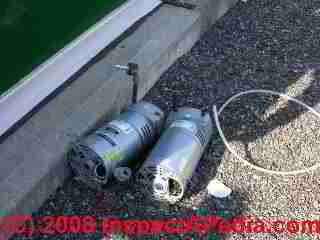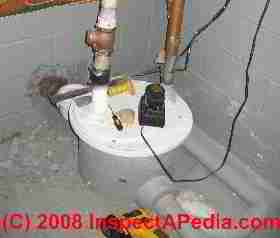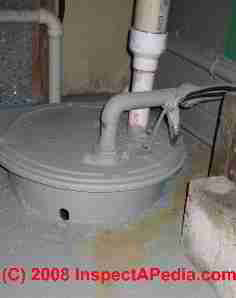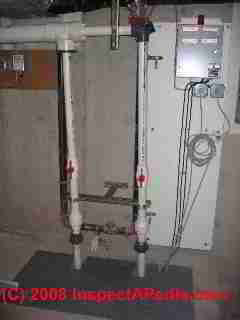 Sewage Ejector Pumps & Septic Pumps
Sewage Ejector Pumps & Septic Pumps
Inspection & Maintenance Guide
- POST a QUESTION or COMMENT about how to inspect & maintain septic pumps, sewage grinder pumps, sewage ejector pumps and pump alarm systems
Septic pumps & grinder pumps:
How to inspect sewage grinder pumps or septic pump installations for proper installation, operation, and testing.
This article gives inspection and maintenance advice for Sump Pumps, Sewage Ejector Pumps, Septic Grinder Pumps, Sewage Pumping Stations, & Septic Pump Alarms.
InspectAPedia tolerates no conflicts of interest. We have no relationship with advertisers, products, or services discussed at this website.
- Daniel Friedman, Publisher/Editor/Author - See WHO ARE WE?
Guide to Sewage Ejector Pump Inspection
 The general name for sewage pumps pumps is sewage grinder pumps if they are intended to grind and move black water or sewage (including solid wastes), or sewage effluent pumps if
the pump is intended only to move clarified effluent, say from a septic tank to a drain field.
The general name for sewage pumps pumps is sewage grinder pumps if they are intended to grind and move black water or sewage (including solid wastes), or sewage effluent pumps if
the pump is intended only to move clarified effluent, say from a septic tank to a drain field.
Some of the common sewage grinder or septic pump brands include ABS pumps, Crane (centrifugal grinders) pumps, Environment One or E/One sewage pumps, Goulds pumps, Hydromatic pumps, Liberty sewage pumps, Little Giant pumps, Myers pumps, Tsurumi pumps, Webtrol sewage pumps, and Zoeller sewage grinder pumps. Several sewage pump manufacturers produce a separate line of commercial or municipal sewage grinder pumps from those used in residential application.
Sketches are from the Environment One Low Pressure Sewer Systems Grinder Pump catalog.
What you see at a building site may indicate a history of problems:
The pumps at page top may have been a misapplication for this municipal lift station ,which may explain why we found these discarded units on the site. Septic pump systems vary by these parameters:
Is the proper pump installed?
Septic pump manufacturers provide a pump selection and sizing table that is used to guide the installer in selecting the proper pump. We've seen sewage handling systems where the wrong type or wrong capacity of pump was installed, sometimes as an attempt to "save money."
Are modifications to the septic pump system visible ? What do they mean?

The septic grinder pump at left has had a hole cut at floor level to permit other basement leakage to enter the pumping chamber to be pumped away.
Of course any sewage backup will flow back out of this hole into the room, and might prevent the pump alarm from functioning - but then is there a pump alarm installed? From the number of wires entering the tank, probably not.
Also we see no check valve (see photo at right, brass valve on the left hand vertical outlet pipe). Also the wiring connections entering the tank are held in place with gray-painted-over masking tape - not particularly reliable.
Guide to Sewage Ejector Pump Maintenance: inspection checklist
 Inspect the sewage grinder tank for the following:
Inspect the sewage grinder tank for the following:
- Accessibility
to the tank and pump for inspection, pump replacement, or repairs - Alarm system:
if installed, check that the alarm operates if the pump pit level rises above normal
See SEPTIC PUMP ALARM SYSTEMS - Backups or overflows
which may show recent failures: sewage or toilet paper scraps outside the pumping chamber, stains, water lines, odors, occupant report - Check valve on the discharge line
is needed at the discharge line (as we show in the photo above).
Unless a check valve is installed, when the septic pump motor turns off you'll hear a large volume of water running backwards into the pumping chamber from the discharge line, causing the pump to turn on again too soon or even to cycle continuously; the check valve also assures that a sewer main does not back up into a building and flood it through the sewage ejector pump system.
See SEPTIC PUMP INSTALLATION - Clogged grinder pump impeller:
clogging in the impeller (reduced discharge or in severe cases loss of pump output, motor trips on overload)
Clogging in a septic effluent pump often occurs when the wrong pump type has been selected and the pump cannot handle solids entering the system. Clogs also occur if improper materials (dental floss, tampons) are flushed down toilets.
Clogged pumps also occur when a white or gray waxy deposit accumulates, often due to bacterial growth or to use of powdered detergents.
See SEPTIC / SEWAGE PUMP WAXY CLOGGING
See SEPTIC / SEWAGE PUMP NO-FLUSH LIST - Clogged discharge line vent:
required in the discharge line at height of top of pump where some check valves such as Zoeller Unicheck are installed. Normal: look for water discharge from this 3/16" opening when the pump is on and briefly at the end of pump-on cycle - Components missing:
confirm the presence of each of the sewage grinder system components shown
at SEPTIC PUMP INSTALLATION where we illustrate a complete pump installation - Debris in the pump basin:
loose debris, wood, hair, string, etc. will clog and damage the pump. - Leaks, exposed wires, unprotected openings
into the pumping chamber or tank - Odors at the sewage or septic pump:
often caused by improper reservoir seal, a bad check valve, or improper venting.
See SEWAGE PUMP ODORS - Operation check for the sewage or septic pump:
turn on a nearby plumbing fixture to fill the reservoir tank, observe the pump operation, turning on and off normally - Pump opening cover:
for safety the sump pumping basin must have a secure, child-proof cover in place; in some installations the cover must also be gas-tight. - Pump type: has the proper type of pump been installed for the application? Don't install a simple basin pump or effluent pump where pumping sewage and solids is required.
At SEPTIC & SEWAGE PUMPS we explain that choosing the wrong type of pump, such as installing a simple basin pump or effluent pump (designed to handle primarily liquid waste) on a system where blackwater (toilet waste) is entering the system is likely to lead to pump clogging and failure.
Pump selection and pump types are discussed
at SEWAGE EJECTOR / GRINDER PUMPS - Reservoir: damaged ejector/grinder pump reservoir or basin:
the fiberglass or plastic container should be intact, with no cracks, breaks, improper holes, or other damage. Some basins are made of cast iron and use a cast iron lid. The lid should fit securely, be of the proper material, and not be leaking. - Venting of the pumping chamber:
Presence of adequate tank venting. Openings in the pumping chamber or tank itself may discharge odors, dangerous sewer gases, or even bacteria and sewage backup into the room. If a vent is omitted, when the pump is running it will create an unwanted vacuum in the sewage reservoir. - Also see the sewage / septic grinder pump diagnosis & repair tips
at SEWAGE PUMP DAMAGE & REPAIR
Septic & Sewage Pump Maintenance Guides & Instructions
- GRINDER PUMP CONTRACT PACKAGE [PDF] (2017) Division Of Utilities And Solid Waste Management, Frederick County, Maryland Department Of Engineering And Planning 4520 Metropolitan Court Frederick Maryland 21704 USA Tel (301) 600-2078 Website: www.frederickcountymd.gov, retrieved 2018/06/19, original source https://frederickcountymd.gov/ DocumentCenter/View/282613/ Grinder-Pump-Package-rev-12-21-17?bidId=
- GRINDER PUMP FAQS for CT [PDF] Groton Connecticut Department of Public Works, retrieved 20178/06/19, original source: http://www.groton-ct.gov/depts/pubwks/docs/Grinder%20Pump%20Website%20info%20the%20hurricane.pdf
- HYDROMATIC GRINDER PUMP SEWAGE SYSTEM OPERATION [PDF] Summit Township, 2121 Ferguson Rd., Jackson MI 49203, Tel: 517 788 4113, retrieved 20178/06/19, original source: http://www.summittwp.com/departments/department_of_public_works1/docs/hydromatic.pdf
- UNIFORM PLUMBING CODE, Chapter 7 SANITARY DRAINAGE [PDF] from Virginia 2006 Plumbing Code, retrieved 20178/06/19, original source: https://www2.iccsafe.org/states/virginia/plumbing/PDFs/Chapter%207_Sanitary%20Drainage.pdf
- PENTAIR HYDROMATIC SUMP, SEWAGE, EFFLUENT PUMP SELECTION GUIDE [PDF], Pentair USA 293 Wright Street, Delavan, Wi 53115 USA, Website : www.hydromatic.com
Tel: 888-957-8677 Orders Fax: 800-426-9446,
Pentair Canada Cambridge, Ontario Tel: 519-896-2163 retrieved 20178/06/19, original source: http://www.resiflowlit.com/pentair/pdf/W-02-6100.pdf - Roeth, Bradley W. P.E., Guide to Selection of Submersible Sewage Pumps [PDF] Bradley W. Roeth, P.E., Stanley Consultants, Muscatine, Iowa retrieved 20178/06/19, original source: http://www.stanleyconsultants.com/files/ 6513/6182/9009/Submersible_Sewerage_Pumps-White_Paper-Roeth.pdf
- SEWAGE PUMP UP PACKAGE [PDF] Pentair
- ZOELLER SUBMERSIBLE GRINDER PUMP OWNERS MANUAL [PDF] for X71 Hazardous Environment Series Class I, Division 1, Group C & D Submersible Grinder Units, Zoeller Engineering, P.O. BOX 16347 Louisville, KY 40256-0347 USA, retrieved 2018/06/19, original source: https://www.zoellerengprod.com/content/literature/zm2209.pdf
- Also see SEPTIC SYSTEM PUMP MANUFACTURERS where you will find additional manuals and instructions for effluent, septic, and sewage pumps
...
Continue reading at SEWAGE PUMP DAMAGE & REPAIR or select a topic from the closely-related articles below, or see the complete ARTICLE INDEX.
Or see SEPTIC PUMP INSPECTION & MAINTENANCE FAQs - questions and answers posted originally on this page.
Or see these
Recommended Articles
- SEWAGE EJECTOR / GRINDER PUMPS - home
- DISPOSABLE WET WIPE CLOGS
- FREE-STANDING GRINDER PUMPS
- SEWAGE TREATMENT PLANTS, RESIDENTIAL
- SEPTIC SYSTEM PUMPS
- SEPTIC PUMP ALARM SYSTEMS
- SEPTIC PUMP BUYERS GUIDE & MANUALS
- SEPTIC PUMP DUPLEX DESIGNS
- SEPTIC PUMP INSPECTION & MAINTENANCE
- SEPTIC PUMP INSTALLATION
- SEWAGE PUMP DAMAGE & REPAIR
- SEWAGE PUMP INTERMITTENT CYCLING
- SEWAGE PUMPING STATIONS
- SEWAGE PUMP BUYERS GUIDE & MANUALS
- SEWAGE PUMP DAMAGE & REPAIR
- SEWAGE PUMP ODORS
- SEWAGE ODOR SOURCE LOCATION
- SEWAGE PUMPING STATIONS
- WAXY BIOFILM SLIME CLOGS in DRAINS & PUMPS
- SUMP PUMPS
Suggested citation for this web page
SEPTIC PUMP INSPECTION & MAINTENANCE at InspectApedia.com - online encyclopedia of building & environmental inspection, testing, diagnosis, repair, & problem prevention advice.
Or see this
INDEX to RELATED ARTICLES: ARTICLE INDEX to SEPTIC SYSTEMS
Or use the SEARCH BOX found below to Ask a Question or Search InspectApedia
Ask a Question or Search InspectApedia
Try the search box just below, or if you prefer, post a question or comment in the Comments box below and we will respond promptly.
Search the InspectApedia website
Note: appearance of your Comment below may be delayed: if your comment contains an image, photograph, web link, or text that looks to the software as if it might be a web link, your posting will appear after it has been approved by a moderator. Apologies for the delay.
Only one image can be added per comment but you can post as many comments, and therefore images, as you like.
You will not receive a notification when a response to your question has been posted.
Please bookmark this page to make it easy for you to check back for our response.
Comments
IF above you see "Comment Form is loading comments..." then COMMENT BOX - countable.ca / bawkbox.com IS NOT WORKING.
In any case you are welcome to send an email directly to us at InspectApedia.com at editor@inspectApedia.com
We'll reply to you directly. Please help us help you by noting, in your email, the URL of the InspectApedia page where you wanted to comment.
Citations & References
In addition to any citations in the article above, a full list is available on request.
- The NSFC Products List has an excellent list of design manuals/modules National Small Flows Clearinghouse (NSFC) now (2019/12/13) hosted at http://www.nesc.wvu.edu/ Tel: 304-293-4191 e-mail info@mail.nesc.wvu.edu.
The National Small Flows Clearinghouse (NSFC) was funded by the U.S. Environmental Protection Agency (EPA) to help America's small communities and individuals solve their wastewater problems through objective information about onsite wastewater collection and treatment systems. NSFC products and information are the only national resource of its type, dealing with small community wastewater infrastructure. or by telephone 800-624-8301 - In addition to citations & references found in this article, see the research citations given at the end of the related articles found at our suggested
CONTINUE READING or RECOMMENDED ARTICLES.
- Carson, Dunlop & Associates Ltd., 120 Carlton Street Suite 407, Toronto ON M5A 4K2. Tel: (416) 964-9415 1-800-268-7070 Email: info@carsondunlop.com. Alan Carson is a past president of ASHI, the American Society of Home Inspectors.
Thanks to Alan Carson and Bob Dunlop, for permission for InspectAPedia to use text excerpts from The HOME REFERENCE BOOK - the Encyclopedia of Homes and to use illustrations from The ILLUSTRATED HOME .
Carson Dunlop Associates provides extensive home inspection education and report writing material. In gratitude we provide links to tsome Carson Dunlop Associates products and services.

